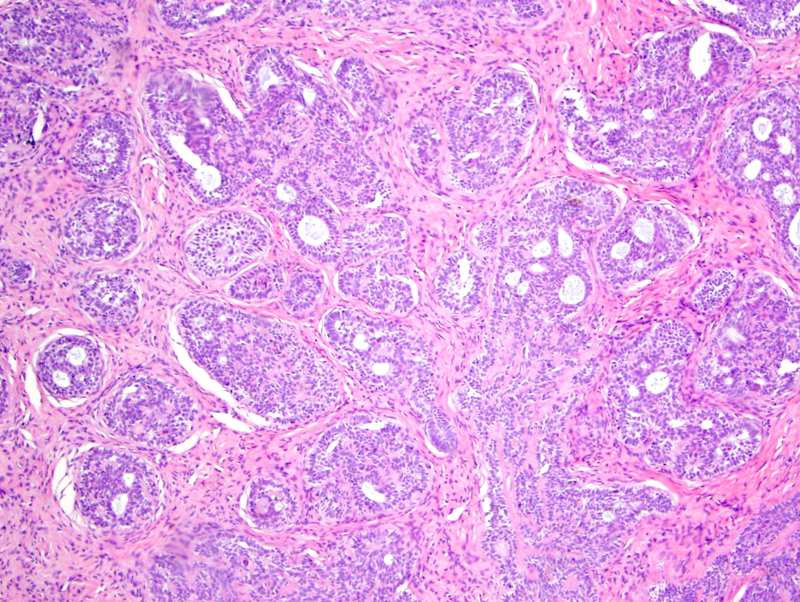

Low power view demonstrating islands of basaloid cells in a background of cellular stroma; this was located in the deep dermis.
High power view better illustrates the basaloid islands and cellular stroma.
Trichoblastoma (TB) is a benign neoplasm of the hair follicle. Some authors consider trichoblastoma to be a variant of trichoepithelioma. The difference between the two is that trichoblastomas are located in the deep dermis and subcutaneous tissue, whereas trichoepitheliomas are more superficial. Furthermore, horn cysts and papillary mesenchymal bodies characteristic of trichoepithelioma are usually not prominent features in trichoblastomas (Alsaad, Rapini).
In both trichoepithelioma and trichoblastoma, the key entity on the differential diagnosis is basal cell carcinoma (BCC). Similarities between trichoblastoma and BCC include a basaloid proliferation with periphal palisading. Mitotic activity can be seen in both entities. However, in BCC, the patient population tends to be older, whereas in TB, the patients are younger. Furthermore, BCC arises in sun-exposed areas whereas TB can arise anywhere in the skin. BCC is more superficial (usually in the dermis), whereas TB is located in the deep dermis or subcutaneous tissue (Alsaad). It is said that the artefactual clefting often seen in BCC is minimal or inconspicuous in TB, however, depending on processing of the tissue, this particular feature may not be all that helpful.
The comparison between BCC and trichoepithelioma will be discussed in our case for trichoepithelioma (see link below).
Trichoblastomas are commonly observed in association within a pre-existing nevus sebaceous (a.k.a. organoid nevus, nevus sebaceous of Jadassohn) or may occasionally co-exist with a basal cell carcinoma. Note that Ackerman has identified five subtypes of trichoblastomas (large nodular, small nodular, cribriform, retiform, and racemiform), but unless you are Dr. Ackerman, you may not be able to distinguish between these subtypes.
Trichoblastomas typically present as skin colored to brown or blue-black papules and/or nodules that are non-ulcerated, solitary masses. The most common location is the head and neck, especially on the scalp and face of adults in the forth to fifth decade of life. They have also been frequently described in the pelvic girdle (Schulz).
Treatment is by complete surgical excision.
Trichoblastoma can rarely transform into trichoblastic carcinoma. Some authors consider trichoblastic carcinoma to be synonymous with basal cell carcinoma, however, it appears that trichoblastic carcinoma arising in a trichoblastoma is more aggressive (higher potential for distant metastases) and has a slightly different morphology (Alsaad, .
→Trichoblastoma is considered a deep variant of trichoepithelioma
→Trichoblastoma is the neoplasm most commonly associated with nevus sebaceous (a.k.a. organoid nevus, nevus sebaceous of Jadassohn)
→The key entity on the differential diagnosis for a trichoblastoma is basal cell carcinoma
• Adnexal : Desmoplastic Trichoepithelioma
• Adnexal : Nevus Sebaceous (Organoid Nevus)
• Epidermis : Basal Cell Carcinoma, Nodular Type
Alsaad KO, et al. Skin adnexal neoplasms - part 1: An approach to tumors of the pilosebaceous unit. J Clin Pathol 2007;60:129-44.
Ackerman AB, de Viragh PA, Chongchitnant N. Neoplasms with follicular differentiation. Philadelphia: Lea & Febiger; 1993:359-420.
Fletcher CDM, ed. Diagnostic Histopathology of Tumors. 3rd Ed. Philadelphia, PA: Elsevier; 2007: 1443-4.
Headington JT. Differentiating neoplasms of hair germ. J Clin Pathol 23:464, 1970.
Schirren CG, et al. Trichoblastoma and basal cell carcinoma are neoplasms with follicular differentiation sharing the same profile of cytokeratin intermediate filaments. Am J Dermatopathol 1997, 19:341–350.
Rapini RP. Practical Dermatopathology. Philadelphia, PA: Elsevier; 2005: PAGE.
Rosai, J. Rosai and Ackerman’s Surgical Pathology, 10th Ed. Philadelphia, PA: Elsevier; 2011: 147.
Schulz T, et al. High-grade trichoblastic carcinoma arising in trichoblastoma: a rare adnexal neoplasm often showing metastatic spread. Am J Dermatopathol. 2005 Feb;27(1):9-16.
Taylor RS, Perone JB, Kaddu S, Kerl H. Chapter 119. Appendage Tumors and Hamartomas of the Skin. In: Wolff K, Goldsmith LA, Katz SI, Gilchrest BA, Paller AS, Leffell DJ, eds. Fitzpatrick's Dermatology in General Medicine. 7th ed. New York: McGraw-Hill; 2008.
